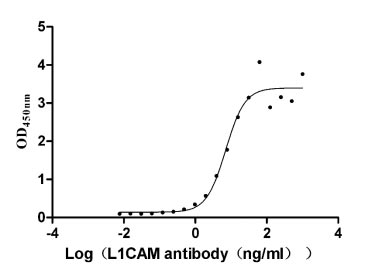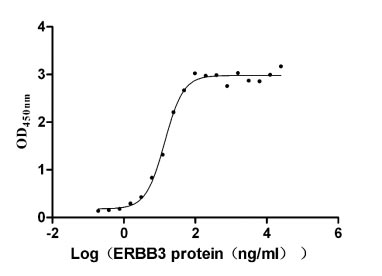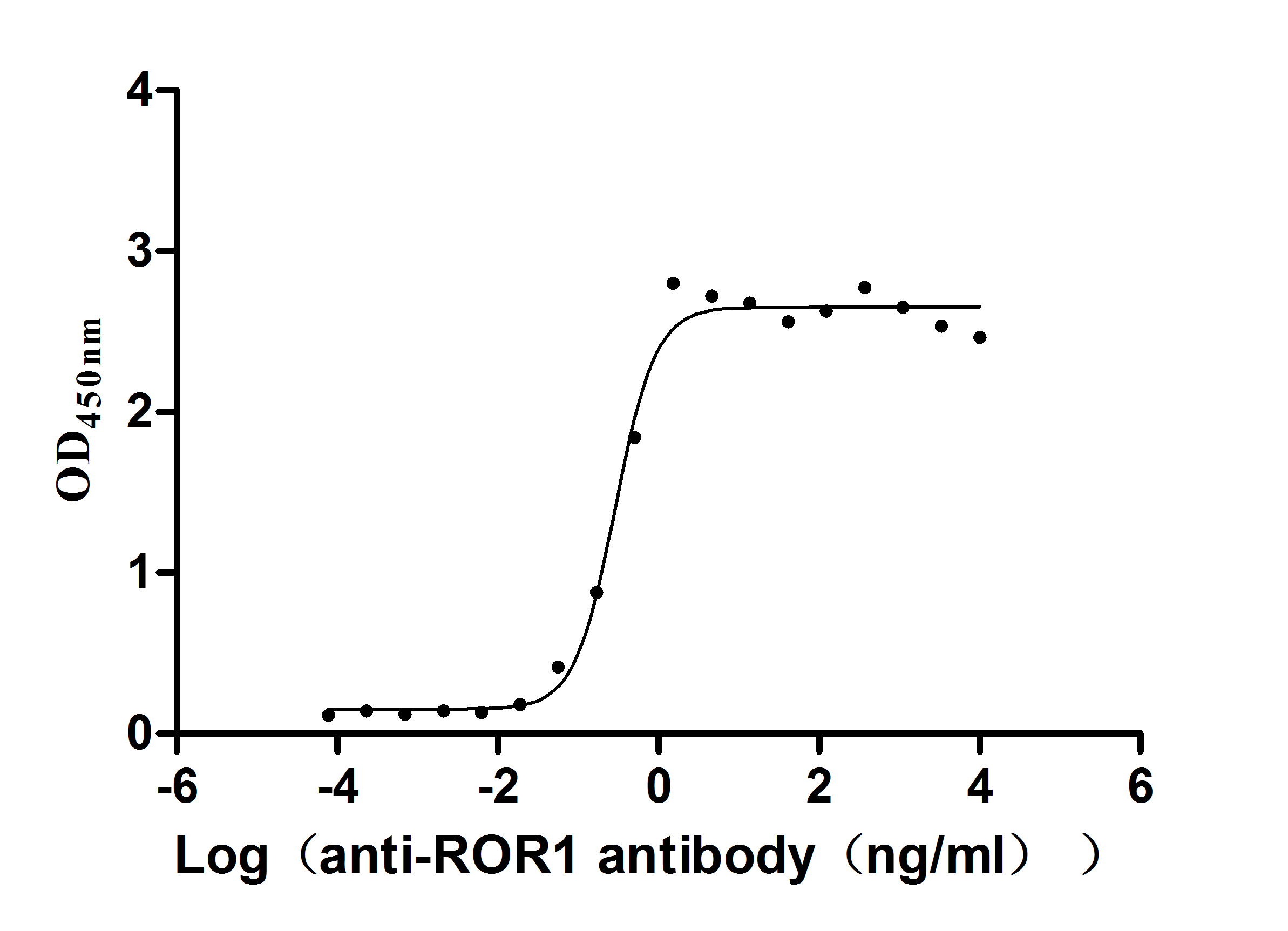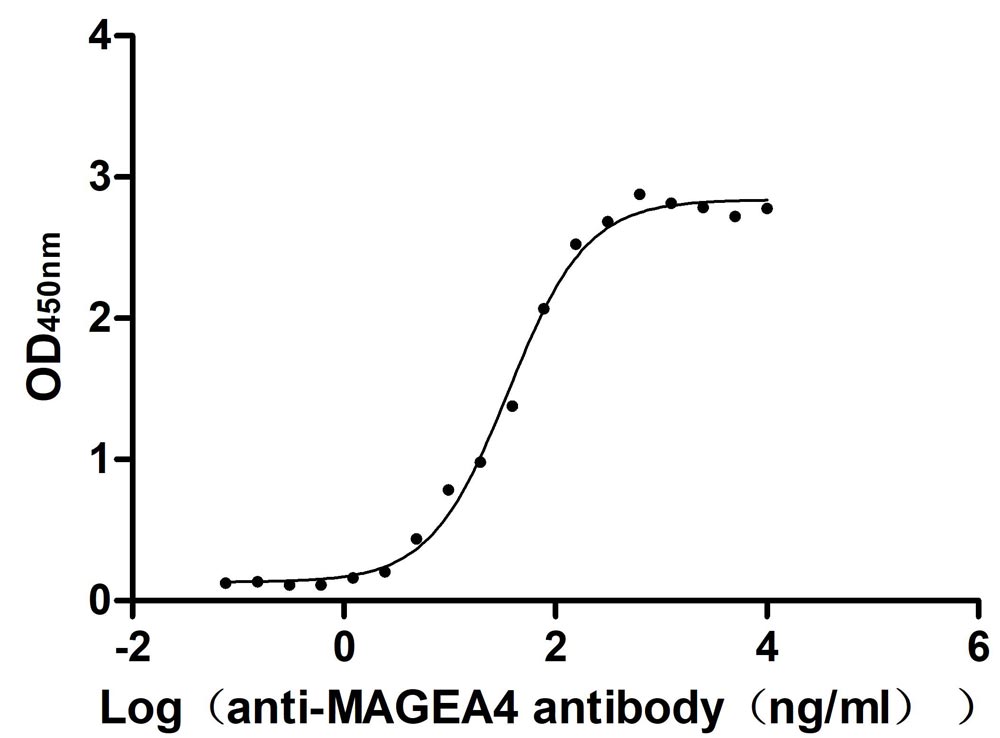Recombinant Human Probable DNA dC->dU-editing enzyme APOBEC-3B (APOBEC3B)
-
中文名称:Recombinant Human Probable DNA dC->dU-editing enzyme APOBEC-3B(APOBEC3B),Yeast
-
货号:CSB-YP887025HU
-
规格:
-
来源:Yeast
-
其他:
-
中文名称:Recombinant Human Probable DNA dC->dU-editing enzyme APOBEC-3B(APOBEC3B),Yeast
-
货号:CSB-EP887025HU
-
规格:
-
来源:E.coli
-
其他:
-
中文名称:Recombinant Human Probable DNA dC->dU-editing enzyme APOBEC-3B(APOBEC3B),Yeast
-
货号:CSB-EP887025HU-B
-
规格:
-
来源:E.coli
-
共轭:Avi-tag Biotinylated
E. coli biotin ligase (BirA) is highly specific in covalently attaching biotin to the 15 amino acid AviTag peptide. This recombinant protein was biotinylated in vivo by AviTag-BirA technology, which method is BriA catalyzes amide linkage between the biotin and the specific lysine of the AviTag.
-
其他:
-
中文名称:Recombinant Human Probable DNA dC->dU-editing enzyme APOBEC-3B(APOBEC3B),Yeast
-
货号:CSB-BP887025HU
-
规格:
-
来源:Baculovirus
-
其他:
-
中文名称:Recombinant Human Probable DNA dC->dU-editing enzyme APOBEC-3B(APOBEC3B),Yeast
-
货号:CSB-MP887025HU
-
规格:
-
来源:Mammalian cell
-
其他:
产品详情
-
纯度:>85% (SDS-PAGE)
-
基因名:APOBEC3B
-
Uniprot No.:
-
别名:APOBEC3BDNA dC->dU-editing enzyme APOBEC-3B; A3B; EC 3.5.4.38; Phorbolin-1-related protein; Phorbolin-2/3
-
种属:Homo sapiens (Human)
-
蛋白长度:full length protein
-
表达区域:1-251
-
氨基酸序列MNPQIRNPMERMYRDTFYDNFENEPILYGRSYTWLCYEVKIKRGRSNLLWDTGVFRGQVY FKPQYHAEMCFLSWFCGNQLPAYKCFQITWFVSWTPCPDCVAKLAEFLSEHPNVTLTISA ARLYYYWERDYRRALCRLSQAGARVTIMDYEEFAYCWENFVYNEGQQFMPWYKFDENYAF LHRTLKEILRLRIFSVAFTAAMRSCASWTWFLLCSWTRPRSTGSLGSSPGAPASPGAVPG KCVRSFRRTHT
-
蛋白标签:Tag type will be determined during the manufacturing process.
The tag type will be determined during production process. If you have specified tag type, please tell us and we will develop the specified tag preferentially. -
产品提供形式:Lyophilized powder
Note: We will preferentially ship the format that we have in stock, however, if you have any special requirement for the format, please remark your requirement when placing the order, we will prepare according to your demand. -
复溶:We recommend that this vial be briefly centrifuged prior to opening to bring the contents to the bottom. Please reconstitute protein in deionized sterile water to a concentration of 0.1-1.0 mg/mL.We recommend to add 5-50% of glycerol (final concentration) and aliquot for long-term storage at -20℃/-80℃. Our default final concentration of glycerol is 50%. Customers could use it as reference.
-
储存条件:Store at -20°C/-80°C upon receipt, aliquoting is necessary for mutiple use. Avoid repeated freeze-thaw cycles.
-
保质期:The shelf life is related to many factors, storage state, buffer ingredients, storage temperature and the stability of the protein itself.
Generally, the shelf life of liquid form is 6 months at -20°C/-80°C. The shelf life of lyophilized form is 12 months at -20°C/-80°C. -
货期:Delivery time may differ from different purchasing way or location, please kindly consult your local distributors for specific delivery time.Note: All of our proteins are default shipped with normal blue ice packs, if you request to ship with dry ice, please communicate with us in advance and extra fees will be charged.
-
注意事项:Repeated freezing and thawing is not recommended. Store working aliquots at 4°C for up to one week.
-
Datasheet :Please contact us to get it.
相关产品
靶点详情
-
功能:DNA deaminase (cytidine deaminase) which acts as an inhibitor of retrovirus replication and retrotransposon mobility via deaminase-dependent and -independent mechanisms. After the penetration of retroviral nucleocapsids into target cells of infection and the initiation of reverse transcription, it can induce the conversion of cytosine to uracil in the minus-sense single-strand viral DNA, leading to G-to-A hypermutations in the subsequent plus-strand viral DNA. The resultant detrimental levels of mutations in the proviral genome, along with a deamination-independent mechanism that works prior to the proviral integration, together exert efficient antiretroviral effects in infected target cells. Selectively targets single-stranded DNA and does not deaminate double-stranded DNA or single- or double-stranded RNA. Exhibits antiviral activity against simian immunodeficiency virus (SIV), hepatitis B virus (HBV) and human T-cell leukemia virus type 1 (HTLV-1) and may inhibit the mobility of LTR and non-LTR retrotransposons.
-
基因功能参考文献:
- the knockdown of APOBEC3B by clustered regularly interspaced short palindromic repeats/CRISPR associated protein 9 resulted in reduced proliferation and enhanced chemosensitivity of glioma cells. Thus, APOBEC3B contributes to glioma progression and may be a future target for therapeutic intervention. PMID: 30226610
- results suggest that B-Myb-A3B contributes to DNA damage and could be targeted by inhibiting EGF receptor. PMID: 28276478
- APOBEC3A/B deletion was associated with young age at diagnosis among the cancer cases for both cancer forms (lung cancer: P = 0.02; dominant model and prostate cancer PMID: 29140415
- These studies combine to indicate that APOBEC3B promotes drug resistance in breast cancer and that inhibiting APOBEC3B-dependent tumor evolvability may be an effective strategy to improve efficacies of targeted cancer therapies. PMID: 27730215
- Our results provide evidence that APOBEC3B can interact with HBV core protein and edit HBV DNAs during reverse transcription. These data suggest that APOBEC3B exerts multifaceted antiviral effects against HBV. PMID: 29129707
- review of current understanding of APOBEC3A and APOBEC3B biology in human papillomavirus Infection restriction, evolution, and associated cancer mutagenesis PMID: 28825669
- This study found that A3B C-terminal domain shows higher activity toward its target sequence in short ssDNA and efficiently deaminates a target sequence located near the center of ssDNA. PMID: 28952713
- Data show that the larger oligomeric state of APOBEC3B (A3B) inhibited its activity. PMID: 28981865
- APOBEC3B*c.783delG showed evidence of modest association with breast cancer and seemed to contribute to earlier onset of the disease. PMID: 28062980
- Data show that APOBEC3B (A3B) expression is inversely related to p53 status in different cancer types and demonstrate that this is due to a direct and pivotal role for p53 in repressing A3B expression. PMID: 28977491
- Structural determinants of APOBEC3B non-catalytic domain for molecular assembly and catalytic regulation have been reported. PMID: 28575276
- A lysine-free derivative of human APOBEC3B was constructed and shown to be indistinguishable from the wild-type enzyme in DNA cytosine deamination, HIV-1 restriction, and nuclear localization activities. PMID: 28841445
- exposures to relevant environmental factors might induce APOBEC3A or APOBEC3B expression above genotoxic levels and initiate tumorigenesis in a tissue-specific manner in the right cellular environment where ssDNA is available PMID: 27643540
- APOBEC3B expression increased the incorporation of genomic uracil, invoked DNA damage response (DDR) biomarkers and caused cell cycle arrest. PMID: 28535155
- The findings demonstrate that covalently-closed circular DNA levels are significantly lower in hepatocellular carcinoma tissues, and that the lower levels are likely to stem in part from up-regulation of APOBEC3B. PMID: 27310677
- Data suggest that heat shock proteins, in particular Hsp90, stimulate APOBEC3-mediated DNA deamination activity toward hepatitis B viral DNA, suggesting a potential physiological role in mutagenesis/carcinogenesis and viral innate immunity; Hsp90 stimulates deamination activity of APOBEC3G, APOBEC3B, and APOBEC3C during co-expression in human liver HepG2 cells. PMID: 28637869
- APOBEC3B mRNA levels are significantly higher in breast cancer metastases as compared to the corresponding estrogen receptor-positive primary tumors. PMID: 28141868
- tumour-infiltrating immune cells may be an important feature of breast cancers arising in women with APOBEC3B germline deletion, and that this may be of particular interest in Asian women where the germline deletion is more common. PMID: 27233495
- the APOBEC3B deletion polymorphism has neither a prognostic nor a predictive value for breast cancer patients. PMID: 27552096
- Single-strand DNA-specific cytidine deaminase APOBEC3B (A3B) damages tRNA genes at 1000-fold higher efficiency than other non-tRNA genomic regions in Saccharomyces cerevisiae. A3B-induced lesions in tRNA genes were predominantly located on non-transcribed strand, while no transcriptional strand bias was observed in protein coding genes. It suggests transcription-dependent mechanism for A3B-induced tRNA gene hypermutation PMID: 28351647
- These data link oncogene, loss of tumour suppressor gene and drug-induced replication stress with APOBEC3B activity, providing new insights into how cytidine deaminase-induced mutagenesis might be activated in tumourigenesis and limited therapeutically. PMID: 27634334
- High APOBEC3B mRNA expression was related to the aggressive phenotypes of breast cancer, high frequency of TP53 mutation and poor prognosis, especially in ER-positive tumors. PMID: 27977754
- crystal structures of human APOBEC3A and a chimera of human APOBEC3B and APOBEC3A bound to ssDNA at 3.1-A and 1.7-A resolution, respectively. PMID: 27991903
- the classical NF-kappaB pathway is responsible for activation of A3B mRNA expression. PMID: 27577680
- Collectively, these results indicate that human papillomavirus 16 E6 induces upregulation of APOBEC3B through increased levels of TEADs, highlighting the importance of the TEAD-APOBEC3B axis in carcinogenesis. PMID: 28077648
- APOBEC3B mRNA expression was higher in OSCCs than in controls. APOBEC3B protein expression was high in both OSCCs and normal samples. PMID: 27818121
- The expression of APOBEC3B in breast cancer was higher than in non-cancerous tissues and was related to the lymph node metastasis and nuclear grade. PMID: 26476745
- results suggest that the APOBEC3A/3B deletion polymorphism is not significantly associated with cancer risk in our study population PMID: 27155849
- This suggests that APOBEC3B deletion may attenuate innate cellular immunity against HIV-1 and thus confer the host persistence for HIV infection. PMID: 27522954
- APOBEC3B expression was increased in some population of tumor cells of drug resistant cell lines. PMID: 27044816
- APOBEC3A and APOBEC3B preferentially deaminate the lagging strand template during DNA replication. PMID: 26832400
- Data indicate that SIVmac239 Vif protein efficiently degrades human DNA cytosine deaminase APOBEC3B protein (huA3B). PMID: 26544511
- Data show that restriction factor APOBEC3G (A3G) is susceptible to degradation by the HIV-1 Vif protein, whereas restriction factor APOBEC3B (A3B) is resistant to Vif. PMID: 26668372
- APOBEC3B is required for regulation of gene expression by ERalpha and acts by causing C-to-U deamination at ERalpha binding regions. PMID: 26411678
- These results suggest that functional potential of APOBEC3B and APOBEC3C involved in cancer mutagenesis is associated with estrogen receptor status. PMID: 26682542
- The APOBEC3B deletion polymorphism was found to be associated with HBV, HCV, TTV, and T. gondii co-infection in Indonesian HIV-infected individuals. PMID: 26305823
- Germline variant and deletion polymorphism in APOBEC3B gene are not associated with breast cancer risk. PMID: 26320772
- APOBEC3B expression was correlated with unfavorable prognosis in patients with gastric cancer. PMID: 26191203
- APOBEC3B expression is an independent predictor of recurrence in patients with ccRCC, and the prognostic value is most prominent in those with low-risk disease. PMID: 26051357
- report the first structures of the APOBEC3B catalytic domain in multiple crystal forms. These structures reveal a tightly closed active site conformation and suggest that substrate accessibility is regulated by adjacent flexible loops PMID: 26416889
- APOBEC3B overexpression and Fhit-loss induced DNA damage are independent events that, when occurring together, result in a significantly increased frequency of APOBEC-induced mutations that drive cancer progression. PMID: 25401976
- The N-terminal domain of A3B and at least three residues involved in DNA binding by the A3Bc catalytic domain contribute to the A3B attenuation of the double stranded DNA break phenotype. PMID: 26384561
- Multiple experimental approaches combined demonstrate direct transcriptional upregulation of APOBEC3B by a signal transduction pathway involving the classical protein kinase C isoform protein kinase Ca and the noncanonical NF-kB transcription factor RELB. PMID: 26420215
- APOBEC3A-mediated mutagenesis is much more frequent than APOBEC3B because APOBEC3A itself is highly proficient at generating DNA breaks. PMID: 26258849
- This study defines and characterizes the catalytic domain of human APOBEC3B (A3B) enzyme. PMID: 26281709
- DNA cytosine and methylcytosine deamination by APOBEC3B: enhancing methylcytosine deamination by engineering APOBEC3B. PMID: 26195824
- Study provides evidence that APOBEC3B is overexpressed in chondrosarcoma tissues and cell lines and interferes with RUNX3 transcription. PMID: 25176183
- High APOBEC3B is associated with the pathogenesis of primary effusion lymphoma. PMID: 25650088
- results indicate that E6 activates the A3B promoter through the distal and proximal regions, and that ZNF384 is required for the proximal-region-mediated activation of A3B PMID: 25800874
- These studies suggest a model in which high-risk human papillomavirus E6 causes derepression of APOBEC3B gene transcription, leading to a mutator phenotype that explains the observed cytosine mutation biases in papillomavirus positive cancers. PMID: 25538195
显示更多
收起更多
-
亚细胞定位:Nucleus.
-
蛋白家族:Cytidine and deoxycytidylate deaminase family
-
组织特异性:Expressed at high and moderate levels in peripheral blood leukocytes, spleen, testes, heart, thymus, prostate and ovary. Also expressed at low levels in several other tissues.
-
数据库链接:
HGNC: 17352
OMIM: 607110
KEGG: hsa:9582
STRING: 9606.ENSP00000327459
UniGene: Hs.226307
Most popular with customers
-
Recombinant Human Neural cell adhesion molecule L1 (L1CAM), partial (Active)
Express system: Mammalian cell
Species: Homo sapiens (Human)
-
Recombinant Human Receptor tyrosine-protein kinase erbB-3 (ERBB3), partial (Active)
Express system: Mammalian cell
Species: Homo sapiens (Human)
-
Express system: Mammalian cell
Species: Homo sapiens (Human)
-
Recombinant Human Melanoma-associated antigen 4 (MAGEA4) (Active)
Express system: Mammalian cell
Species: Homo sapiens (Human)
-
Recombinant Human Intestinal-type alkaline phosphatase (ALPI) (Active)
Express system: Mammalian cell
Species: Homo sapiens (Human)
-
Recombinant Dog Angiopoietin-2 (ANGPT2) (Active)
Express system: Mammalian cell
Species: Canis lupus familiaris (Dog) (Canis familiaris)
-
Recombinant Human V-set and immunoglobulin domain-containing protein 4 (VSIG4), partial (Active)
Express system: Mammalian cell
Species: Homo sapiens (Human)
-
Recombinant Human Interleukin-2 receptor subunit alpha (IL2RA), partial (Active)
Express system: Mammalian cell
Species: Homo sapiens (Human)




















